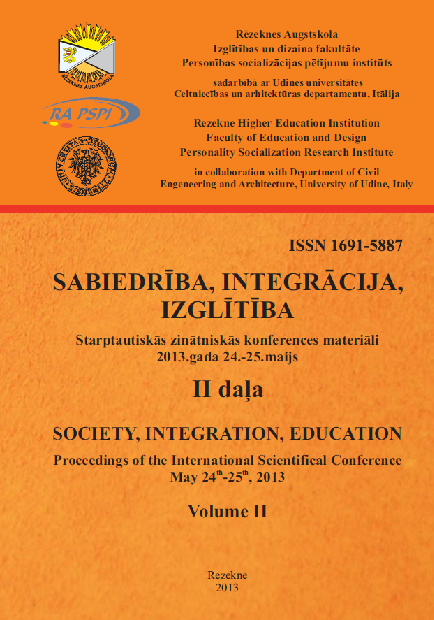REVEALING GHOST BUSINESS-TO-BUSINESS CLIENTS THROUGH GOSH’S MODEL. A CHALLENGE FOR EU LEISURE AND ENTERTAINMENT ACTIVITIES
DOI:
https://doi.org/10.17770/sie2013vol2.587Keywords:
business-to-business market, competitive advantage, footholds, input-output analysis, integration, recreational, cultural and sporting activities, resource-based theory, trade contactsAbstract
The concept of intermediate market trade contacts (ITC) have been developed as transactional capital resource measured by business-to-business purchases or sales. In the framework of the resource-based view, only valuable, rare, inimitable and non-substitutable firm's resources might be considered as a source of sustained competitive advantage. Supplydriven Ghosh's model has been applied to Eurostat symmetric input-output tables of 23 EU countries. A strong and direct relationship between market horizontal multiplier for productive use and indirect ITC frequency has been found for recreational, cultural and sporting activities. Consequently, valuable and distinct hidden-client purchases could be used as a resource favoring firm development, innovation and territorial integration strategies.Downloads
References
Amit, R.; & Schoemaker, P. (1993). Strategic assets and organizational rent. Strategic Management Journal, 14, 33-46.
Barney, J. (1991). Firm Resources and Sustained Competitive Advantage. Journal of Management, (17)1, 99-120.
Barney, J. (2001). Is the Resource-Based “”view” a Useful Perspective for Strategic Management Research? Yes. The Academy of Management Review, 26(1), 41-56.
Chang, T.F.M. (1994). L’analisi della struttura del sistema agroalimentare. Sistema agroalimentare e mercati agricoli, (a cura di) Cesaretti GP, Mariani AC, Sodano V. Bologna: Il Mulino.
Chang, T. F. M.; & Iseppi, L. (2011). Specialization versus Diversification in EU Economies: a Challenge for Agro-food? Transition Studies Review, 18(1), 16-37.
Chang, T. F. M.; & Iseppi, L. (2012). EU Agro-Food Chain and Vertical Integration Potentiality: a Strategy for Diversification? Transition Studies Review, 19(1), 107-130.
Chen, C.Y.; & Rose, A. (1986). The Joint Stability of Input-Output Production and Allocation Coefficients. Research Paper 8617. National Cheng Kung University.
Combs, J.G.; & Ketchen, J.J.; & Ireland, R.; & Webb, J.W. (2011). The role of resource flexibility in leveraging resource. Journal of Management Studies, 48(5), 1098-1125.
Daft, R.L. (2009). Organization theory and design, Thomson Learning, Mason.
Droli, M. (2007). Partnering turistico. L’impostazione, la creazione, l’organizzazione ed il rinforzo continuo di una partnership strategica di successo. Collana Ambiente e Territorio. Udine: FORUM.
Droli, M. (2012). Vantaggio co-marketing. Mercati difficili, lavoro di squadra e rilancio dell’Italian Style. Collana Scienze economiche. Padova: Edizioni universitarie CLEUP.
Droli, M.; & Chang, T.F.M.; & Iseppi, L.; & Piccinini, L.C. (2013). Managing Trade Contacts in HotRest Intermediate Markets: a Resource-based View Analysis in EU Countries. Under review.
Eurostat (2012). http://epp.eurostat.ec.europa.eu/portal/page/portal/esa95_supply_use_input_tables/data/workbooks.
Dierickx, I.; & Cool, K. (1989). Asset stock accumulation and sustainability of competitive advantage. Management Science, 35, 1504-1511.
Ghosh, A. (1958). Input-Output Approach in an Allocation System. Economica, 25(97), 58-64.
Hansen, M. H.; & Hoskisson, R.E.; & Barney, J. B. (2000). Resolving the opportunism minimization-opportunity maximization paradox. Working paper, Fisher College of Business. Columbus: Ohio State University.
Lippman, S. A.; & Rumelt, R.P. (1982). Uncertain inimitability: An analysis of interfirm differences in efficiency under competition. Bell Journal of Economics, 13, 418-438.
Peteraf, M. (1993). The cornerstones of competitive advantage: A resource-based view. Strategic Management Journal, 14, 179-191.
Priem, R.L.; & Butler J.E. (2001). Is the Resource-Based "View" a Useful Perspective for Strategic Management Research?. The Academy of Management Review, 26(1), 22-40.
Rumelt, R. (1984). Towards a strategic theory of the firm. In R. Lamb (Ed.), Competitive strategic management, 556- 570. Englewood Cliffs, NJ: Prentice-Hall.
Tomer, J.F. (1987). Organizational capital: The path to higher productivity and wellbeing. New York: Praeger.
Schoemaker, P.J.H. (1990). Strategy, complexity and economic rent. Management Science, 36, 1178-1192.
Upson, J.K.; & Ketchen, D.J.; & Connelly, B.L.; & Ranft, A.L. (2012). Competitor Analysis and Foothold Moves. Academy of Management Journal, 55, 93-110.
Wernerfelt, B. (2011). The use of resources in resource acquisition. Journal of Management, 37, 1369-1373.


